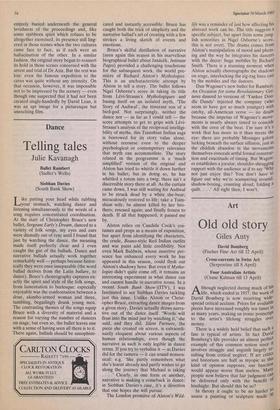Dance
Telling tales
Julie Kavanagh
Ballet Rambert (Sadler's Wells) Siobban Davies (South Bank Show) Like patting your head while rubbing your stomach, watching dance and listening simultaneously to the words of a song requires concentrated coordination. At the start of Christopher Bruce's new ballet, Sergeant Early's Dream, danced to a variety of folk songs, my eyes and ears were dismally out of sync until I found that just by watching the dance, the meaning made itself perfectly clear and I even caught the gist of the ballads. Dance and narrative ballads actually work together remarkably well — perhaps because histor- ically they were once inseparable (the word ballad derives from the Latin ballare, to dance). Bruce's choreography captures ex- actly the spirit and style of the folk songs, from lamentation to burlesque: especially enjoyable was the confrontation between a dour, akimbo-armed woman and three, tumbling, beguilingly drunk young men. The contrasting themes of the songs equip Bruce with a diversity of material and a reason for varying the number of dancers on stage; but even so, the ballet leaves one with a sense of having seen all there is to it. There again, ballads should be unsophisti- cated and instantly accessible: Bruce has caught both the trick of simplicity and the narrative ballad's art of creating with a few strokes a living sketch of events and emotions.
Bruce's skilful distillation of narrative (seen again this season in his marvellous biographical ballet about Janacek, Intimate Pages) provided a challenging touchstone for the subsequent work, the world pre- mière of Richard Alston's Mythologies. This is an uncharacteristic attempt by Alston to tell a story. The ballet follows Nigel Osborne's score in taking its title from Levi-Strauss's Mythologiques and basing itself on an isolated myth, 'The Story of Asdiwal', the itinerant son of a bird-god. Not surprisingly, neither the dance nor — as far as I could tell — the score attempts to get to grips with Levi- Strauss's analysis of the reciprocal intelligi- bility of myths, this Tsimshian Indian saga is borrowed for its story value alone, without recourse even to the deeper psychological or contemporary relevance that myth can accommodate. The story related in the programme is a 'much simplified' version of the original and Alston has tried to whittle it down further in his ballet; but in doing so, he has whittled a totem into a twig: there isn't a discernible story there at all. As the curtain came down, I was still waiting for Asdiwal to be struck dead by a white she-bear; miraculously restored to life; take a Tsim- shian wife; be almost killed by her bro- thers; rescued again; and finally frozen to death. If all that happened, it passed me by.
Alston relies on Candida Cook's cos- tumes and props as a means of exposition, but apart from identifying the characters, the crude, Beano-style Red Indian outfits and war paint add little credibility. Not even Mark Baldwin, whose assertive pre- sence has enhanced every work he has appeared in this season, could flesh out Alston's shadowy hero. But even if Mytho- logies didn't quite come off, it remains an interesting experiment in what dance can and cannot handle in narrative terms. In a recent South Bank Show KITV), I was fascinated to see Siobhan Davies tackling just this issue. Unlike Alston or Christ- opher Bruce, extracting dance images from a given story, Davies actually draws narra- tive out of the dance itself. 'Words will float into the mind just by watching it,' she said, and they did. Silent Partners, the piece she created on screen, is extraordi- narily eloquent about various aspects of human relationships, even though the narrative as such is only legible in dance terms. If you try to verbalise it — as Davies did for the camera — it can sound nonsen- sical: e.g. 'She partly remembers what she's learnt already and partly wishes to go along the journey that Michael is taking . . . .' Clearly, in one form or another, narrative is making a comeback in dance: in Siobhan Davies's case, it's a direction that one hopes she will pursue.
The London premiere of Alston's Wild- life was a reminder of just how affecting his abstract work can be. The title suggests a specific subject, but apart from some jung- lish sonorities in Nigel Osborne's score, this is not overt. The drama comes from Alston's manipulation of mood and phras- ing and the way he integrates his dancers with the decor: huge mobiles by Richard Smith. There is a stunning moment when Alston actually choreographs the shadows on stage, interlocking the zig-zag lines cast by the mobiles and the dancers.
Dan Wagoner's new ballet for Rambert, An Occasion for some Revolutionary Ges- tures danced to versions of 'Yankee Doo- dle Dandy' injected the company (who seem to have got so much younger) with catchy, all-American verve — no doubt because the impetus of Wagoner's move- ments is nearly always timed to coincide with the crest of the beat. I'm sure it's a work that has more to it than meets the eye: there are probably Messages galore lurking beneath the surface silliness, just as the childish abandon in the movements themselves conceals artful formal construc- tion and exactitude of timing. But Wagon- er establishes a jocular, shoulder-shrugging rapport with the audience as if to say 'NOY not just enjoy this? You don't have to figure out why we're scampering around, shadow-boxing, counting aloud, folding 8 quilt. . . All right then, I won't.














































 Previous page
Previous page